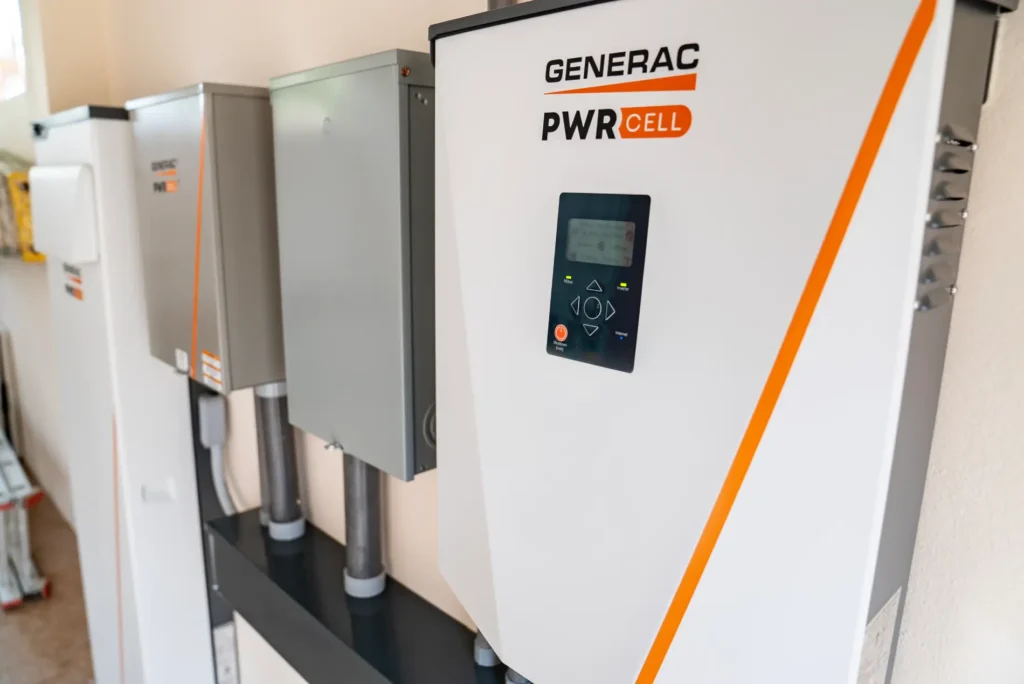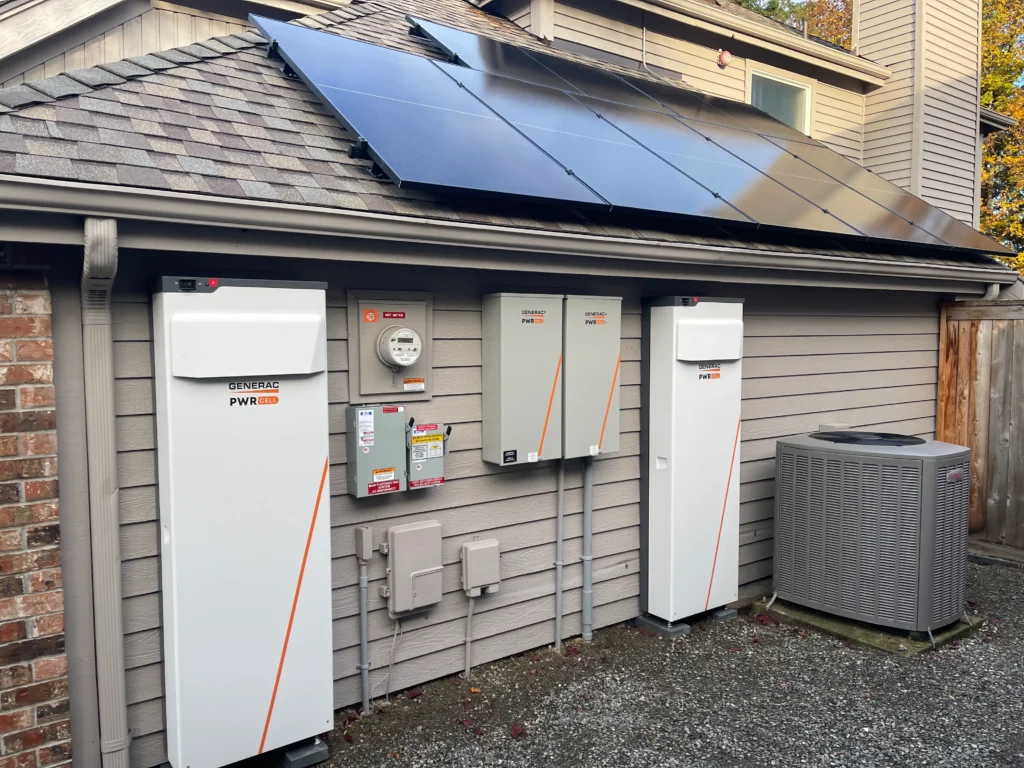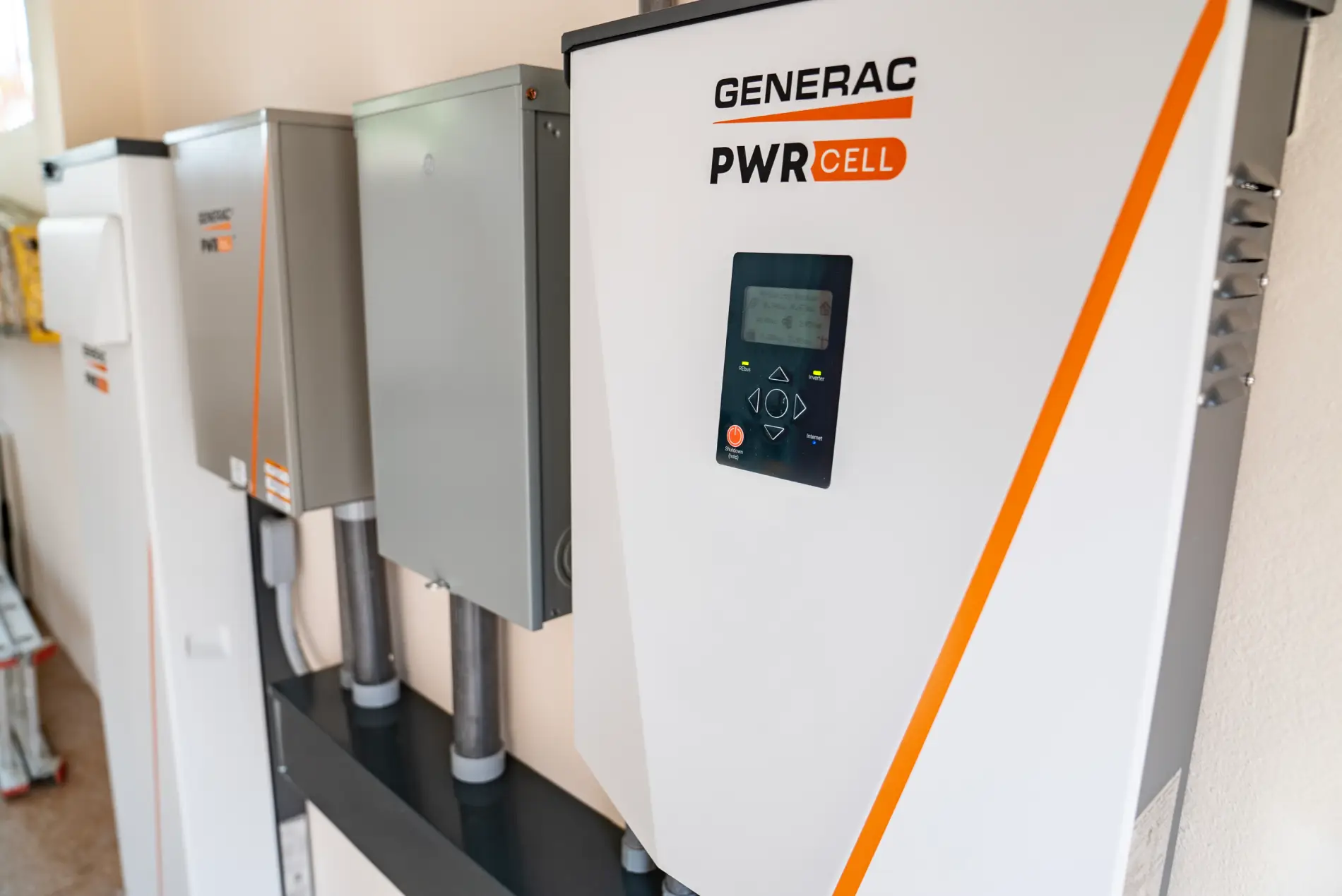A solar battery backup ensures your home stays powered–even when the grid goes down. These systems work hand-in-hand with advanced solar energy systems, storing extra energy produced during the day so you can use it at night or during unexpected outages.
If you’re a homeowner looking to cut energy costs, reduce reliance on the grid, or simply feel more prepared, a solar battery backup system is a smart, long-term investment. With the right setup, you can achieve greater grid-free energy security and peace of mind during blackouts and lower your electric bills over time.
In this guide, we’ll walk you through everything you need to know–from how solar battery backups work to what they cost and how to choose the best system for your home.

What is a Solar Battery Backup?
Solar battery backups store excess energy from your panels for use during outages or at night, helping reduce grid dependence and boost home resilience.
While most systems offer basic storage–discharging power as needed–only a few offer intelligent load management. Generac PWRcell, for example, includes PWRmanager technology that dynamically prioritizes circuits based on real-time usage and battery state. Most other systems simply provide general backup to preset circuits without any automated load control.
A typical solar battery backup system includes advanced solar energy systems, inverters, a battery, and, crucially, a critical load panel or automatic transfer switch (ATS). These components isolate and power essential appliances during an outage. Without them, the system cannot safely or efficiently deliver continuous energy independence.
Some systems use hybrid inverters that handle both solar and battery functions, while many retrofits rely on AC-coupled configurations–using separate inverters for solar and storage–which are more compatible with existing systems but often less efficient.
Monitoring and controlling software is also common, providing visibility into system performance and energy usage.
How Does a Solar Battery Backup Work?
A solar battery backup stores excess electricity generated by advanced solar energy systems. During the day, energy is stored for later use, ensuring that power is available even when the sun isn’t shining. This stored energy can be used at night, during peak demand hours, or in the event of a grid outage.
How Energy is Stored and Used
- Advanced solar energy systems generate electricity by converting sunlight into direct current (DC) power.
- The hybrid inverter system converts this DC power. DC power turns into alternating current (AC) power for home use.
- Any excess energy that isn’t immediately used is stored. The smart battery uses intelligent load management.
Supporting the Home During Grid Outages
When a power outage occurs, the solar battery backup automatically activates. This provides a supply of electricity to the home. Essential appliances (refrigerators, medical devices, and lighting) continue to function without interruption.
Benefits of Having a Solar Battery Backup
A solar battery backup offers energy resilience without reliance on the grid, cost savings, and reliable continuous energy independence. By storing excess solar energy, homeowners reduce reliance on the grid.
Energy Independence
A solar battery backup reduces reliance on the grid by storing excess solar energy for later use. Off-grid solar batteries can be especially beneficial. Both high-cost electricity markets and areas prone to outages should consider this option.
Backup During Outages
Solar battery backup systems ensure essential appliances remain powered. During blackouts caused by storms or grid instability, your lighting stays on.
Cost Savings
Reduce electricity bills and lower reliance on expensive grid power. Maximize self-consumption of solar energy with a backup system.
Environmental Impact
Stored solar energy replaces fossil fuel-generated electricity. This reduces carbon emissions and supports clean energy use.
Incentives & Rebates
- Federal Tax Credit: The 30% Investment Tax Credit (ITC) allows homeowners to claim a significant portion of their solar + battery system costs.
- Net Metering: Homeowners can earn credits for excess solar power sent to the grid, further offsetting electricity expenses.
- Washington Solar Incentives: The Washington state sales tax waiver covers up to 10% of the total system cost. Check local programs for additional savings opportunities.
Factors That Influence Pricing
- Battery Size & Capacity: Larger batteries with higher storage capacity cost more but provide longer continuous energy independence.
- Battery Type: Lithium-ion batteries are more expensive than lead-acid batteries but offer greater efficiency and longevity.
- Brand & Features: Smart batteries with intelligent load management provide more value but may have a higher initial cost.
Long-Term Benefits & Savings
While the upfront investment may seem significant, homeowners benefit from lower electricity bills, increased home value, and available tax incentives. The 30% Federal Tax Credit and Washington state sales tax waiver significantly reduce costs.
If you’re in Washington, Clean Energy Innovators provides expertly engineered solar battery backup solutions tailored to your energy needs.

How to Choose the Right Solar Battery Backup System
Choosing the right solar battery backup system means evaluating factors like capacity, efficiency, lifespan, and system compatibility. In most cases, advanced solar energy systems and battery storage are installed together as part of a new clean energy system.
While it’s possible to add a battery to an existing solar setup, only about 5% of residences currently have solar, and retrofitting can be expensive.
Upgrades may require microinverters or additional hardware to make the system compatible, adding to the overall cost and complexity.
Capacity and Power
Battery capacity, measured in kilowatt-hours (kWh), determines how long stored energy can power your home. Larger households or high-energy users may require higher-capacity batteries for extended backup.
Efficiency Ratings
A battery’s round-trip efficiency reflects how much stored energy is usable. Higher efficiency (90% or more) minimizes energy loss.
Lifespan & Warranty
Most intelligent backup systems last 10-15 years, with warranties ranging from 5-15 years. A longer lifespan ensures a better return on investment.
Compatibility
When considering a solar battery backup, compatibility with your current system is critical—especially for homes with existing advanced solar energy systems. Most older solar setups use string inverters (like SMA or Fronius) or microinverters (such as Enphase IQ6/7), which aren’t compatible with DC-coupled batteries.
As a result, adding a battery often means replacing or supplementing the inverter, which increases overall costs.
Retrofitted systems typically use AC-coupled batteries (like Tesla Powerwall or Enphase IQ Battery). These are more installation-friendly for existing solar, but they often require electrical panel upgrades, permitting, and interconnection approvals, all of which can add complexity and reduce efficiency compared to DC-coupled systems.
Additionally, to supply continuous energy independence, most setups require a critical load panel or automatic transfer switch (ATS)—both of which must be installed by a licensed electrician. These components ensure the battery powers only essential circuits during an outage, but they are not plug-and-play and increase the system’s cost and complexity.
Talk to the Experts
Working with solar battery storage companies helps homeowners find the best system for their needs. If you’re in the Puget Sound area, CE Innovators provides tailored battery backup solutions designed for maximum reliability and performance.
Top Factors to Consider Before Installing a Solar Battery Backup
Before investing in a solar battery backup system, consider your energy needs, incentives, and system compatibility.
Home Energy Needs
Assess your daily energy consumption and peak power requirements. Larger homes or those with high-energy appliances may need higher-capacity batteries for reliable backup.
Local Regulations and Incentives
Permits, building codes, and tax credits impact installation costs. Programs like the Washington state sales tax waiver and the 30% Federal Tax Credit help make solar battery systems more affordable. Research state and local incentives to maximize savings.
Grid-Tied vs. Off-Grid Systems
- Grid-Tied Systems: Works with the grid and allows for net metering credits.
- Off-Grid Systems: Provides total grid-free energy security but requires larger battery capacity.
Emergency Preparedness
Ensure the battery can power critical appliances for extended periods during an outage.
FAQs About Solar Battery Backup Systems
1. Do I need a solar battery backup if I have solar panels?
Yes. Advanced solar energy systems alone do not provide power during grid outages. Without a battery, excess solar energy is sent to the grid instead of being stored for later use.
2. How long can a solar battery power my home during an outage?
Backup duration depends on your battery’s capacity, energy usage, and which appliances are running. A 10 kWh battery can typically support essential loads—like a refrigerator, a few lights, and internet equipment—for 12 hours, depending on how conservatively energy is used. If additional appliances like a furnace fan, well pump, or microwave are running, backup time may be much shorter.
The definition of “essential” varies by household, and real-world usage often drains batteries faster than expected. Systems with intelligent load management—such as Generac PWRmanager—can extend backup time by automatically shedding or staggering non-critical loads.
Without such features, managing usage manually becomes essential to prolong battery life during outages.
3. Can I add a battery backup to an existing solar system?
It’s possible, but often requires significant upgrades. Many existing systems—especially those with older string inverters or microinverters—aren’t battery-ready. Adding backup may involve installing a new inverter, using an AC-coupled battery like the Tesla Powerwall, and adding a critical load panel or transfer switch.
Permitting and electrical upgrades may also be needed. Integration is feasible, but it can be complex and costly depending on your current setup.
4. What maintenance is required for solar batteries?
Most lithium-ion solar batteries need minimal maintenance. Regular system monitoring ensures optimal performance while occasional firmware updates improve efficiency.
Ready to Harness the Full Power of Solar?
A solar battery backup offers more than just stored energy. It provides energy resilience without reliance on the grid, cost savings, and reliable power during outages. Maximize your energy use, reduce your reliance on the grid, and protect your home from blackouts. Integrate intelligent energy storage with your solar system today.
Tax incentives make installing a solar battery backup a wise long-term investment. It pays off in energy savings and home value.
Work with solar battery storage companies like CE Innovators. Ensure a system that is expertly engineered for the energy demands of the Pacific Northwest.

